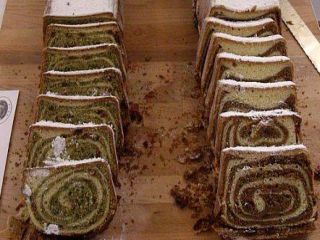


If you cannot decide which one to make, or you are not sure how to prepare one, we recommend you to skim through the book “Potice iz Slovenije” (‘Potica’ from Slovenia) by the ethnologist Janez Bogataj.
You will not believe this, but there are as many various types of ‘potica’ as a wide range of savoury and sweet fillings. In Slovenia, the walnut ‘potica’ is most usually prepared; however, this is only one of the possible varieties. Recently, savoury types of ‘potica’ have been given a lot of attention, such as those filled with bacon, the Kranjska sausage, cheese, mushrooms, spinach, tarragon (sweet or savoury varieties), and more. Regarding sweet types of ‘potica’ – besides the chocolate and tarragon ones – you can make a ‘potica’ with dry plums, cherries, strawberries, apricots, or other sweet fillings.
Janez Bogataj did a detailed research on ‘potica’ in Slovenia
The acknowledged Slovene ethnologist and cultural anthropologist Janez Bogataj examined this favourite dessert and wrote a eulogy to it in his comprehensive 240-page monograph entitled "Potice iz Slovenije". At the presentation of his book, Janez Bogataj, PhD, said for MMC: "The Slovenes should be particularly proud of ‘potica’ of all kinds, as it is an extraordinary delicacy of our cuisine. Moreover, all trends in gastronomy turn to the roots of the cuisine of our remote ancestors. Whichever country you visit, there they will always offer you their local specialities. In Slovenia, ‘potica’ should be more provided in patisseries and places which offer desserts and savoury dishes. Nowadays, it’s easier to get a ‘burek’ than a cheese ‘potica’, which is the absurd!"
The monograph is a research work
The book "Potice iz Slovenije" represents a history of ‘potica’ from the earliest records to the present time. The comprehensive description of the historical development of ‘potica’ is followed by the second part of the book with 28 recipes for sweet and 12 recipes for savoury types of ‘potica’. Janez Bogataj has for several years been collecting the recipes used in all Slovene regions.
Among advices for the preparation of ‘potica’ you will find out the secrets about how long it takes for ‘potica’ dough to rise, and everything you need to know about the thickness of the filling. One important fact is also that ‘potica’ is baked in a ‘potičnik’ (TN: a round earthen cake pan with a tube in the middle). It is merely the sweetbread of round shape with a hole in the middle that is deservedly called ‘potica’ (according to historical records: ‘povitica’).
The Slovenes – ‘Potica’ is the pride of our country! Bake it! Offer it!
‘Potica’ was, and still is, a very important ingredient of the national identity of the Slovenes (besides the Kranjska sausage, a carnation, folk music, and similar symbols). In 2006, the Slovenes adopted gastronomy strategy. Being the most recognizable Slovene dish, the tarragon ‘potica’ is at the top of Slovenia’s pyramid structure. This is because Slovenia is one of the few countries in Europe and in the world to use tarragon also for most diverse sweet dishes.
There are so many different types of ‘potica’ that at the end of his monograph the author added a section in which he suggests a particular ‘potica’ for each individual month and religious festival. Mr Bogataj explains: "The recipe is simple – the filling should be made of seasonal ingredients, which grow in your garden or in the surroundings, ranging from chestnuts, mushrooms, dried fruits, apples and more!"
Tanja Mojzer, translated by D. M.

































































